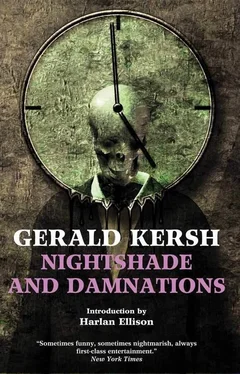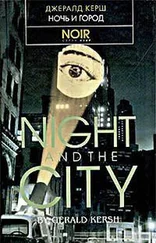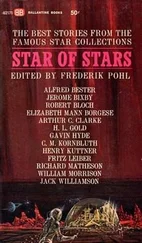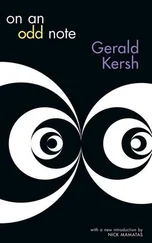Джералд Керш - Nightshade and Damnations
Здесь есть возможность читать онлайн «Джералд Керш - Nightshade and Damnations» весь текст электронной книги совершенно бесплатно (целиком полную версию без сокращений). В некоторых случаях можно слушать аудио, скачать через торрент в формате fb2 и присутствует краткое содержание. Город: Richmond, Год выпуска: 2013, Издательство: Valancourt Books, Жанр: Фантастика и фэнтези, на английском языке. Описание произведения, (предисловие) а так же отзывы посетителей доступны на портале библиотеки ЛибКат.
- Название:Nightshade and Damnations
- Автор:
- Издательство:Valancourt Books
- Жанр:
- Год:2013
- Город:Richmond
- ISBN:нет данных
- Рейтинг книги:3 / 5. Голосов: 1
-
Избранное:Добавить в избранное
- Отзывы:
-
Ваша оценка:
- 60
- 1
- 2
- 3
- 4
- 5
Nightshade and Damnations: краткое содержание, описание и аннотация
Предлагаем к чтению аннотацию, описание, краткое содержание или предисловие (зависит от того, что написал сам автор книги «Nightshade and Damnations»). Если вы не нашли необходимую информацию о книге — напишите в комментариях, мы постараемся отыскать её.
Nightshade and Damnations — читать онлайн бесплатно полную книгу (весь текст) целиком
Ниже представлен текст книги, разбитый по страницам. Система сохранения места последней прочитанной страницы, позволяет с удобством читать онлайн бесплатно книгу «Nightshade and Damnations», без необходимости каждый раз заново искать на чём Вы остановились. Поставьте закладку, и сможете в любой момент перейти на страницу, на которой закончили чтение.
Интервал:
Закладка:
Gerald Kersh
NIGHTSHADE AND DAMNATIONS
INTRODUCTION
Kersh, the Demon Prince
Nightmares, phantasmagoria, horrors that lurk in the streets of today, the corrupting weaknesses of men; these are the bones and gristle of what this book contains.
The flesh is the talent of Gerald Kersh.
In England, Kersh is a much-revered author. His books are seldom out of print. They honor and respect him. Which is a bit unusual, when one considers that Kersh is an American, and that here in America we barely know his work. In ugly point of fact, his brilliant novels Night and the City and A Long Cool Day in Hell cannot be obtained, and the very best of his works, Fowlers End , has never been reprinted.
It gives one pause. Why should it be so? Almost any hack who can write in something that approximates the English language can get published these days. Lady novelists unfit to carry Kersh’s pencil box sell millions in paperback. Non-novelists who rearrange the facts of contemporary history in narrative form find themselves lionized. Rock singers mislabeled poets scatter the pearls of their illiteracy across the bookstalls and get lotta pieces green paper in return. Then why should it be true that a man who has been captivating audiences with his offbeat and penetrating stories for over a quarter of a century should find it close to impossible to reach a wide American audience . . . ?
I’ll be nice today. I won’t castigate the American reading public. It is too often led to the literary slaughter for me to kick it in the rump while it waits for the butcher’s hook. I’ll offer instead a totally specious reason for Kersh’s unfamiliarity to most readers, and thereby work into a rationale for this book having been edited by a man who has never met Gerald Kersh.
Burn your newspaper!
Shut your door and slip the police latch!
Sit with lights out in a darkness that deepens!
Now . . .
Now you begin to live in the dark night of the soul.
And in that endless night you meet Kersh.
Kersh, damn him, the Demon Prince. Who speaks thus:
“We hang about the necks of our tomorrows like hungry harlots about the necks of penniless sailors.”
Kersh, who can describe the indescribable:
“A man has a shape; a crowd has no shape and no color. The massed faces of a hundred thousand men make one blank pallor; their clothes add up to a shadow; they have no words. This man might have been one hundred-thousandth part of the featureless whiteness, the dull grayness, and the toneless murmuring of a docile multitude. He was something less than nondescript—he was blurred, without identity, like a smudged fingerprint. His suit was of some dim shade between brown and gray. His shirt had gray-blue stripes, his tie was patterned with dots like confetti trodden into the dust, and his oddment of limp brownish mustache resembled a cigarette-butt, disintegrating shred by shred in a tea-saucer.”
Damn thee, Kersh, bastard! How many times have I tried to describe such a man and crumbled the paper into my waste basket? How many times have I sought the images, and never found them? Damn you, Kersh, for showing me, and all of us who strive to capture magic in a shot glass, how much better you are, how much more easily you can do it! For someone who has never tried to write, it looks simple. But like all great art—like the dancing of Fred Astaire and the silken sculpture of Calder—its complexity is best expressed by its appearance of simplicity.
No, I’ve never met Kersh. But I’m editing Kersh, because it takes one to know one.
It takes somebody who writes about households filled with LSD hippies who turn into vampires to know somebody who writes about a man who is pursued by men without bones. It takes somebody who writes of the soul of a hooker trapped in a slot machine to know somebody who writes of the man who found the Lid to the Under World. It takes somebody who knows the face of nightmare to truly introduce somebody who deals in nightshade and damnations.
As you may have gathered, I admire Gerald Kersh and his work almost shamelessly. His stories have intrigued and stimulated me for many years. When I was asked to put together this marvelous group of stories, I considered it a rare privilege and honor.
Then I set about reading everything I’ve ever read by Kersh, not to mention half-a-hundred others that had slipped past me somehow. From those stories I’ve selected what I consider to be the very finest, most memorable pieces Kersh’s endlessly inventive mind has let escape.
But in the selection, oh what serendipity! what side benefits! what extra treasures I found:
A phrase of such penetrating rationality, that I had it printed on big yellow cards, which I give to my friends, that reads:
“. . . there are men whom one hates until a certain moment when one sees, through a chink in their armor, the writhing of something nailed down and in torment.”
A random chance phrase that captured my imagination wholly; stopped me, stunned, at the perfection of the imagery:
“A storm broke, and at every clap of thunder the whole black sky splintered like a window struck by a bullet—starred and cracked in ten thousand directions letting in flashes of dazzling light, so that I was stunned and bewildered.”
A special character, who lumbered or flopped or hurled himself across the pages of a story so unforgettably that he became a real person, someone added to my list of authentic acquaintances.
But it is not merely for the terror and strangeness and breath-holding qualities that I commend these Kersh fables to you. Each of them says something potent and immediate about the world in which we live.
Depending on how you want your mind bent, “Whatever Happened to Corporal Cuckoo?” once and for all demolishes the myth of military nobility . . . or solidifies it for all time.
“The Queen of Pig Island” says something new and terrible about the nature of love. “The Ape and the Mystery” indicates a rational size for the cap-A in Art. “A Lucky Day for the Boar” might well be printed as a small pamphlet and included in any orientation kit given to young executives starting in at advertising agencies. “Voices in the Dust of Annan” and “The Brighton Monster” comment with a kind of hideous clarity on war and where it leads us.
And I’ve included “Busto Is a Ghost, Too Mean to Give Us a Fright!” because of the sheer unexcelled brilliance of the descriptions therein. There are others, as well, that make salient points about what is happening to you today . . . but mostly they’re here because they are whopping good yarns.
Kersh still writes, and better than ever, I’d venture. But he isn’t a bright-eyed, bushy-quilled writer of twenty any longer. As Kersh is so painfully persistent in reminding us, we all die. But most men die, and no one knows they have passed this way. It can never be so with Kersh. He is leaving a legacy—expanding with each impact of a typewriter key—that has influenced, and is still influencing, generations of younger writers.
By the excellence of what he has done, Gerald Kersh infuriates and spurs other writers to try and beat him at his own game.
Perhaps one day, one of us will realize that it is impossible to beat a Demon Prince. The sonofabitch uses magic. No mortal can write this well.
Harlan EllisonNew York City
September 5, 1967
Harlan Ellison (b. 1934) is a prolific American writer best known for his short stories and screenplays in the science fiction genre. In over fifty years of writing, he has created over seventy books, ten screenplays, numerous television scripts, and seventeen hundred short stories. The Washington Post called him “one of the greatest living American short story writers,” and the Los Angeles Times proclaimed him the “20th Century Lewis Carroll.” He has won the Hugo Award nine times, the Nebula Award four times, the Bram Stoker Award five times, including its lifetime achievement award, the Edgar Award twice, and the World Fantasy Award twice, among many other awards. He lives in California.
Читать дальшеИнтервал:
Закладка:
Похожие книги на «Nightshade and Damnations»
Представляем Вашему вниманию похожие книги на «Nightshade and Damnations» списком для выбора. Мы отобрали схожую по названию и смыслу литературу в надежде предоставить читателям больше вариантов отыскать новые, интересные, ещё непрочитанные произведения.
Обсуждение, отзывы о книге «Nightshade and Damnations» и просто собственные мнения читателей. Оставьте ваши комментарии, напишите, что Вы думаете о произведении, его смысле или главных героях. Укажите что конкретно понравилось, а что нет, и почему Вы так считаете.






